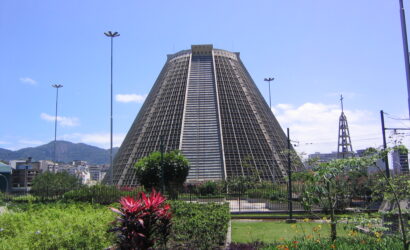Full day tour in
Rio de
Janeiro
Talking a little about
Explore the main tourist attractions of Rio de Janeiro on an unforgettable tour that includes the Christ the Redeemer statue, Sugarloaf Mountain, Maracanã Stadium (external view), the Lapa Arches, the Selarón Steps, the Metropolitan Cathedral of Saint Sebastian, and the Sambadrome (external view), providing a journey that encompasses the majestic nature, iconic architecture, and rich culture of the marvelous city.
Region
Southeast
Type of tours
full day tour
Climate
Atlantic tropical
Include
Transfer, Guide, Admissions and Lunch

About the
Points visited
The “Monumento Natural dos Morros do Pão de Açúcar e da Urca” is a complex of hills located in the Urca neighborhood, in the city of Rio de Janeiro, Brazil. It is composed of the Sugarloaf Mountain (which gives its name to the complex) and the Urca Mountain. Along with the Christ the Redeemer statue, it is the largest postcard of the city of Rio de Janeiro and one of the most famous in Brazil. Due to its unique characteristics, bordered by the waters of Guanabara Bay, it constitutes an international tourist reference for the city.
“Cristo Redentor” is an art deco statue depicting Jesus Christ, located atop the Corcovado mountain, 709 meters above sea level, overlooking a significant part of the Brazilian city of Rio de Janeiro. Made of reinforced concrete and soapstone, it stands at thirty meters in height (one of the largest statues in the world), not including the eight-meter pedestal. Its arms stretch out over 28 meters in width, and the structure weighs 1,145 tons.
The Selarón Steps, also known as the Santa Teresa Convent Staircase and officially named Rua Manuel Carneiro, are located between the neighborhoods of Santa Teresa and Lapa in the city of Rio de Janeiro. It’s just a 5-minute walk to the Lapa Arches. The staircase consists of 215 steps measuring 125 meters in length, all covered with over two thousand tiles collected from more than sixty countries around the world. Selarón began his work on the staircase after ‘finishing’ one section, constantly replacing the tiles so that it would be an ever-evolving piece of art. Selarón considered the work “never complete” and always stated: “This crazy and unique dream will only end on the day of my death.”
The Maracanã River has a length of 8,510 meters from its source in the northern slope of the Tijuca Massif to its mouth, making it one of the rivers that contribute to the Mangue Channel, which in turn feeds into Guanabara Bay. Considered one of the main rivers in Greater Tijuca, the river, responsible for the neighborhood’s name, is one of the focal points of discussions regarding floods in the municipality of Rio de Janeiro.
The Lapa Arches are located in the Lapa district, in the Central Zone of the municipality of Rio de Janeiro, Brazil. Considered the largest architectural work undertaken in Brazil during the colonial period, it is now one of the city’s postcards, the most representative symbol of old Rio de Janeiro preserved in the bohemian region of Lapa.
The Cathedral of Saint Sebastian of Rio de Janeiro, also known as the Metropolitan Cathedral of Rio de Janeiro, is a Catholic cathedral located in the city center of Rio de Janeiro, Brazil. It was inaugurated in 1979, replacing the Church of Our Lady of Carmo as the city’s cathedral. In a modern architectural style, it has a conical shape, with a diameter of 106 meters, an external height of 75 meters, an internal height of 64 meters, and a capacity for 20,000 standing people. One distinctive feature of the building, with its clean and sober lines, is the colorful stained glass windows that extend from the walls to the dome. The project and execution were coordinated by Monsignor Ivo Antônio Calliari (1918 – 2005).






